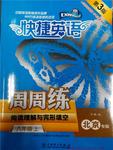题目内容
The coyote(丛林狼)that clever animal of wide-open spaces has come to the nation’s captial. In fact, coyotes have spread to every corner of the United States, changing their behaviors to fit new environments and causing researchers to deal with a troublesome new kind of creature: the city coyote.
The coyote originally lived in the middle of the continent. One of its most obvious characters is its smartness, which has made the animal a notorious(臭名昭著的)pest. Hunters trapped, shot and poisoned more than a million coyotes in the 1900s.It’s still one of America’s most hunted animals. Yet the coyote has survived. How has the coyote shown this extraordinary ability? “I guess if you wanted to use one word, it’d be ‘plasticity’.” says Erie Gese, an expert at Utah State University. Coyotes can live alone, in pairs, or in large packs like wolves, hunt at night or during the day , occupy a small region or an area up to 40 square miles; and live on all sorts of food, from lizards(蜥蜴)and shoes, to ants and melons.
Unbelievably people helped coyotes increase when they killed most of the wolves in the United States. The spreading of coyotes into city areas, though is recent. They travel at night, crossing sidewalks and bridges,running along roads and ducking into culverts (钻入涵洞)and underpasses .No one knows why coyotes are moving into cities, but experts explain that cleverer, more human-tolerant(不怕人的)coyotes are teaching urban survival skills to new generations.
Occasionally,coyotes might attack human beings. There have been about 160 attacks on people in recent years Therefore, people have been consistently told not to feed coyotes or leave pet food unsecured. That plus a large trapping program in the neighborhood, has cut down on the coyote population.
1. The underlined word “plasticity” in Paragraph 2 refers to____________.
A. the ability to fit the environment B. notorious smartness
C. hunting ability D. being human-tolerant
2. The aim of the passage is to_____________.
A. tell people how to fight against coyotes
B. tell us why the coyote is the most hunted animal
C. supply the reason why the coyote is a kind of motorious pest
D. explain how the coyote has spread to and survived in cities
3. According to the passage, coyotes__________.
A. originally lived in the west of the continent
B. sleep during the day but look for food at night
C. are teaching survival skills to their younger generations
D. suffered a population decrease because people killed wolves
4. According to the passage, to cut down on the coyote population, people are advised to_______.
A. leave pet food secured B. keep coyotes in small regions
C. force coyotes to live alone D. avoid using trapping programs
ADCA

 快捷英语周周练系列答案
快捷英语周周练系列答案I bent down in the shade under a sixty-foot-tall cactus(仙人掌), waiting for them to appear. The time was eight thirty in the morning. For seven mornings I had come to the same distant spot in the Sonoran Desert, in southern Arizona. I was here to watch the roadrunner, a small fast-running bird.
I spotted two birds under a bush with red flowers. The roadrunners rushed out from under it. The birds moved rapidly on long skinny legs. Their feathers were brown and black. Their tails were seven inches long. Roadrunners use the tail for balance when running.
That day, the roadrunners performed a courtship(求婚)dance. They ran in wild circles. Suddenly, one stopped and stood still, its round eyes full of light. The second bird took hold of a small stick off the ground and presented it to the first, a gift serving as a symbol of their partnership.
I returned to the spot each day, leaving bits of boiled chicken hoping they would return. Roadrunners eat snakes, lizards, mice, beetles, and spiders. Food is in short supply in the desert, so my offerings were welcome. The pair grew used to me.
Soon after the pair finished building their nest six white eggs appeared in the nest bowl. In about three weeks, six roadrunner chicks, skin as black as coal, cried for food. Their parents brought food such as fence lizards and stink bugs. They fed their young until they were a month and a half old.
Early one morning, a coyote(丛林狼)came around, nose to the ground, for fresh bird meat. The roadrunners fearlessly drove the coyote away, but it was soon back. After three attacks the coyote went away for good, tail between its legs.
I stopped watching the nest when the little roadrunners, at two months of age, were ready to live on their own. It was hard to break away from “my roadrunner family.” Whenever I see a roadrunner now, rushing over the ground, I say hello to it as an old friend.
【小题1】The author went to the Sonoran Desert to .
| A.go on a tour of the desert |
| B.carry out research into some animals in the desert |
| C.make an observation about a kind of bird |
| D.enjoy an adventure in southern Arizona |
| A.They have short tails and legs. |
| B.They move at a fast pace. |
| C.Their feathers are red and brown. |
| D.They don’t like boiled chicken. |
| A.brave | B.clever | C.easily-frightened | D.lazy |
| A.How do roadrunners seek a partner? |
| B.My close friendship with roadrunners. |
| C.Roadrunner family in the Sonoran Desert. |
| D.How did I find roadrunners in Arizona? |